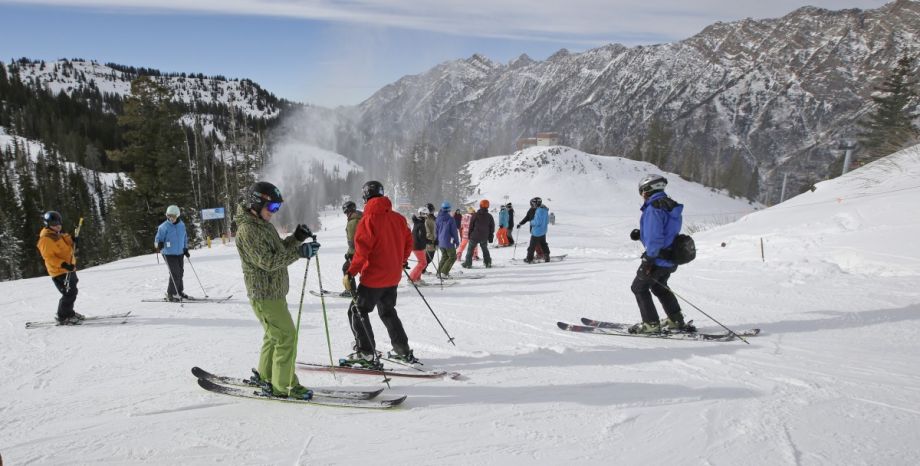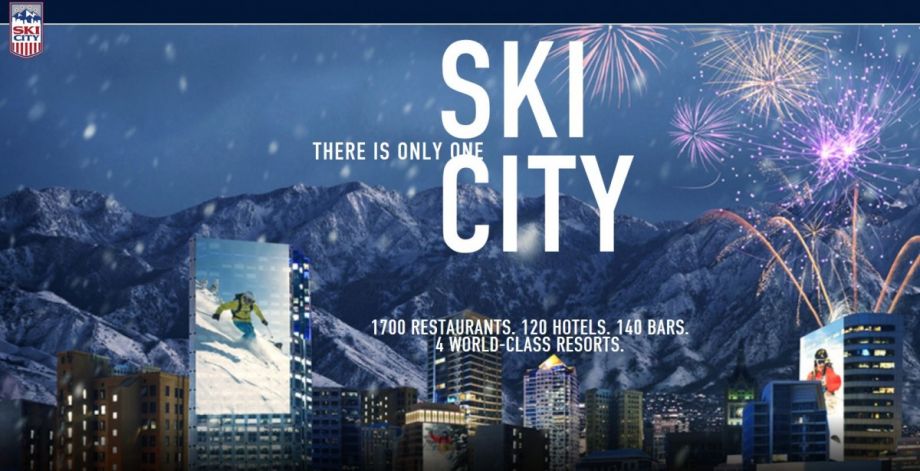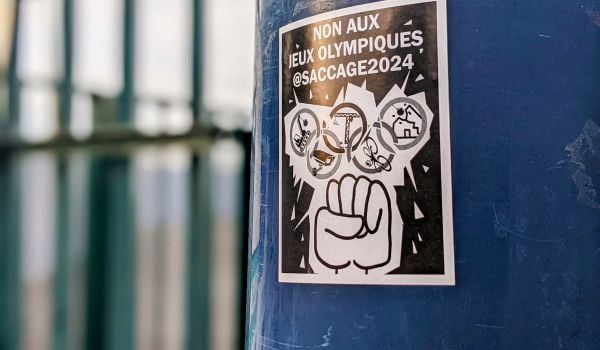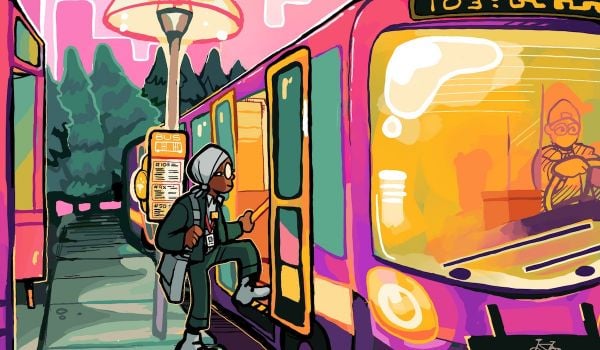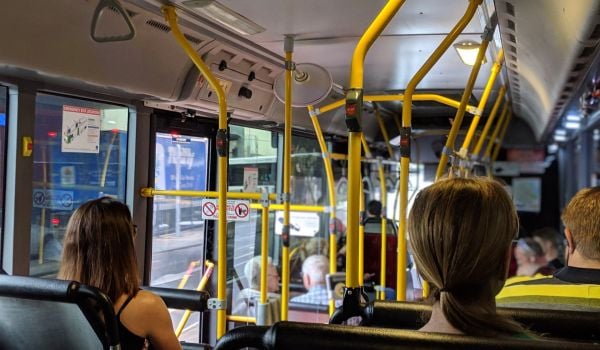It’s the time of year when travel ads crank the winter theme on full blast: charming ski village strolls, quaint lodges with roaring fireplaces. To secure its slice of the $12 billion winter sports market, Salt Lake City is banking on a new approach this winter. The “Ski City” campaign — tagline: “You’ll never stay in a ski town again” — promotes public transit infrastructure to help visitors make the most of the Utah capital’s affordable urban experience and proximity to world-class skiing.
As host of the 2002 Winter Olympics, Salt Lake’s winter sports bona fides are hardly in doubt. In fact, Scott Beck, president and CEO of Visit Salt Lake, the campaign’s mastermind, says, “The motivation was to find a winter tourism brand that could exploit what is intrinsically unique to Ski City post-Olympics.”
It’s a concept that subtropical Sochi struggles with, while Utah would have ranked 10th in medal count at this year’s Winter Games were it an independent country based on the success of its hometown athletes, who train on the Olympic facilities. “More than most cities that have hosted the games, Salt Lake City has done the best in not having any white elephants leftover,” affirms Mike Korologos, former ski writer for the Salt Lake Tribune and a member of the Games’ local organizing committee. (Just this week, the International Olympic Committee relaxed rules so that Pyeongchang, South Korea won’t have to build a bobsled venue with no afterlife when it hosts the 2018 Olympics.)
For Salt Lake, Beck explains, “[The campaign] is much more ‘this is what we should have been calling it [all along]’ than a ‘why now.’” The skiing community (including the resorts and equipment brands) is already a major contributor to the metro economy as part of the outdoor recreation cluster established by the Governor’s Office of Economic Development in 2009. “[Ski City] is a term with a lot of street cred,” Beck says, citing the recent arrival of gear manufacturer Scott USA’s headquarters, joining industry heavyweights like Black Diamond.
At the same time, there is more to life in Salt Lake for visitors than powder in a growing downtown core with a new performing arts center and a burgeoning bar and restaurant scene. It’s a secret locals know well. “I’ve skied in the morning, golfed nine holes in the afternoon, and gone to dinner and the ballet with my wife in the evening. That’s the beauty of Salt Lake,” reflects Korologos.
While the snow-capped Wasatch Mountains, home to seven resorts, are clearly visible from downtown, skiers can’t exactly hop on a chairlift at Salt Lake City’s Temple Square the way nearby Park City boasts trails ending at Main Street. The Utah Transit Authority (UTA), however, runs a popular ski bus service that was first implemented in 1976 at the behest of the closest resorts, reachable only along windy, two-lane canyon roads. “The four resorts in Big and Little Cottonwood Canyons recognized that key limiting factors for skier growth were lack of parking and inability (due to Forest Service restrictions) to build more,” says Remi Barron, a UTA spokesperson.
Currently, the ski bus serves those four local resorts — Solitude, Brighton, Snowbird and Alta — for the duration of their seasons, as well as employee-only bus service to Park City, which lies on the back side of the Wasatch and is reachable via interstate. To incentivize use, season pass holders receive free rides, as do purchasers of Super Pass, a multi-day lift ticket sold by Visit Salt Lake valid at any of those resorts. Park-and-rides are available at the base of the canyons, and Super Pass holders also get free rides on TRAX, UTA’s light rail that was expanded during the Olympics, in order to reach the ski bus lines.
For a one-year period from 2013-2014, total ridership reached nearly 125,000, with Super Pass holders clocking around 30,000 rider days last season. According to Beck, 40 percent of Utah’s annual 2.1 million “destination” skiers, or about 840,000, use the greater Salt Lake area as their base for lodging. Given the discrepancy between these figures, Korologos says, “Bus service is helpful but it is not nirvana.” It’s an issue local leaders know well, especially Mayor Ralph Becker, who says, “As one of the fastest-growing regions in the country, it’s contingent on municipal, state and federal leaders to plan now for transit solutions that accomplish both mobility and environmental goals.”However, the minimal lodging options at the closest resorts and the competition generated by the city’s choices — for accommodations and restaurants alike — make Salt Lake a much more affordable option than a ski town, where prices are often inflated. To that end, the ski bus is well poised to capture more budget-conscious travelers. According to Jennifer Leaver, a research analyst at the University of Utah’s Bureau of Economic and Business Research, the average daily room rate in 2014 was $102.09 and peak season occupancy was 68.7 percent. By contrast, in 2011, the average daily room rate topped $300 in Colorado’s tony Vail and Aspen, while even Steamboat Springs, whose slogan Ski Town USA led to a lawsuit over the Salt Lake campaign’s original incarnation as Ski City USA, charged $167 per night.
Given the plethora of options, both skiing and otherwise, easily accessible from Salt Lake City International Airport, which broke ground on a $1.8-billion new terminal in July, the reality of Ski City is visible from the picture windows that frame the downtown skyline with a mountain background. To keep Ski City sustainable, the challenge remains diverting those visitors from the rental car lot to the TRAX station.
The Works is made possible with the support of the Surdna Foundation.

Gregory Scruggs is a Seattle-based independent journalist who writes about solutions for cities. He has covered major international forums on urbanization, climate change, and sustainable development where he has interviewed dozens of mayors and high-ranking officials in order to tell powerful stories about humanity’s urban future. He has reported at street level from more than two dozen countries on solutions to hot-button issues facing cities, from housing to transportation to civic engagement to social equity. In 2017, he won a United Nations Correspondents Association award for his coverage of global urbanization and the UN’s Habitat III summit on the future of cities. He is a member of the American Institute of Certified Planners.


